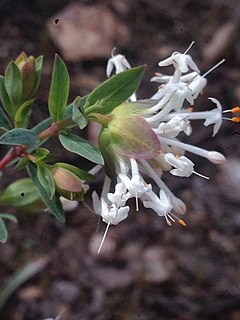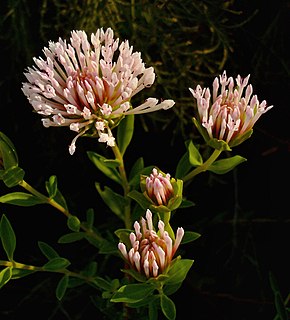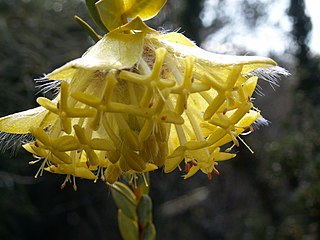
Pimelea, commonly known as rice flowers, is a genus of plants belonging to the family Thymelaeaceae. There are about 150 species, including 110 in Australia and thirty six in New Zealand.

Pimelea linifolia, commonly known as slender rice flower is a common, variable shrub widespread throughout eastern Australia. It has narrow leaves arranged in opposite pairs, and usually white flowers arranged in heads of seven or more on the ends of the stems, with four lance-shaped bracts at the base of the inflorescence. The plant may be toxic to livestock.
Pimelea microcephala is a dioecious shrub in the family Thymelaeaceae, native to Australia. It grows up to 4 metres high and produces greenish-yellow flowerheads. The male flowerheads have 13 to 100 flowers while the female flowerheads have 7 to 12. The leaves are 7 to 40 mm long and 1 to 4 mm wide.

Pimelea humilis, also known as common riceflower or dwarf riceflower, is a shrub in the family Thymelaeaceae, native to Australia. It grows up to 0.5 metres in height. Flowerheads have 12 to 52 whitish flowers that are either female or bisexual. The leaves are 5 to 15 mm long and 2 to 8 mm wide.

Pimelea flava is a shrub in the family Thymelaeaceae which is endemic to Australia.

Pimelea octophylla, commonly known as woolly riceflower or downy riceflower, is a shrub in the family Thymelaeaceae. The speciesis native to south-eastern Australia. It grows up to 1 metre high and produces cream to pale yellow terminal flowerheads with long white hairs. The flowerheads have 25 to 150 flowers. The leaves are 2 to 15 mm long and 0.5 to 5 mm wide.

Pimelea spectabilis, or Bunjong, is a species of shrub in the family Thymelaeaceae, endemic to Western Australia. It is erect in habit, growing to between 0.5 and 2 metres high. The pink and white flowers are produced between August and December in its native range.

Pimelea calcicola is a species of shrub in the family Thymelaeaceae, endemic to Western Australia. It is erect or spreading in habit, growing to between 0.2 and 1 metre high. Pink flowers are produced between September and November in its native range.

Pimelea suaveolens, commonly known as the scented banjine or silky-yellow banjine is a slender shrub with large, rather hairy yellow inflorescences. It ranges in forest areas of the south-west of Western Australia from New Norcia to Albany.
Pimelea ciliolaris is a species of small shrub of the family Thymelaeaceae. It is native to Australia.
Pimelea glauca, commonly known as smooth riceflower, is a species of small shrub in the family Thymelaeaceae. It is native to Australia. It is not considered to be threatened.
Pimelea rosea is a species of small shrub, of the family Thymelaeaceae. It is native to Australia, and is found mostly along the southwestern coast. It is not considered threatened.
Pimelea virgata is a species of small shrub, of the family Thymelaeaceae. It is native to Australia.
Pimelea imbricata is a small shrub species in the family Thymelaeaceae. It is native to Western Australia.
Pimelea longiflora is a species of small shrub in the family Thymelaeaceae. It is native to Western Australia.
Pimelea nivea is a species of small shrub, of the family Thymelaeaceae. It is native to Australia, where it is endemic to Tasmania.
Pimelea pauciflora is a species of shrub in the family Thymelaeaceae. It is native to Eastern Australia.
Pimelea sericea is a species of shrub in the family Thymelaeaceae. It is native to Australia, specifically Tasmania.
Pimelea traversii is a species of shrub in the family Thymelaeaceae. It is native to New Zealand. The specific epithet traversii is in honor of naturalist Henry H. Travers (1844-1928), son of William Thomas Locke Travers.
Pimelea neo-anglica is a species of shrub in the family Thymelaeaceae. It is native to Australia, specifically Queensland.










